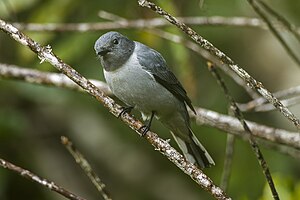Madagascar caterpillar
| Madagascar caterpillar | ||||||||||||
|---|---|---|---|---|---|---|---|---|---|---|---|---|

Madagascar caterpillar ( Coracina cinerea ) |
||||||||||||
| Systematics | ||||||||||||
|
||||||||||||
| Scientific name | ||||||||||||
| Coracina cinerea | ||||||||||||
| ( Statius Müller , 1776) |
The Madagascar crawler catcher ( Coracina cinerea ) is an endemic in Madagascar occurring bird from the family of cuckooshrike (Campephagidae).
features
Madagascar caterpillars reach a body length of 22 to 24 centimeters and a weight of 41.5 to 45.0 grams. There is a weak sexual dimorphism between the sexes in terms of plumage color . The head and neck of the males are black. The back, the control feathers and the wings are ash gray; Chest, flanks and belly white-gray, rarely also yellowish. The only difference between the females is their dark gray head and their overall appearance is somewhat paler than the males.
distribution and habitat
The distribution area of the Madagascar caterpillars covers a wide coastal strip around the entire island of Madagascar. They prefer to settle there in evergreen forests, mangrove forests and forest edges rich in shrubbery from the plains to altitudes of 2300 meters.
Taxonomy
In addition to the nominate form Coracina cinerea cinerea , which occurs in the north and east of Madagascar, another subspecies is known:
- Coracina cinerea pallida Delacour , 1931, in the west and south of the island
- The birds, sometimes referred to as C. sulphurea , are merely a rarely occurring, light sulfur-yellow color variant of Coracina cinerea .
The caterpillars found on the Comoros have long been listed as a subspecies of Coracina cinerea . In the meantime, Coracina cucullata ( Milne-Edwards & Oustalet , 1885) with the subspecies Coracina cucullata cucullata on Grande Comore and Coracina cuculata moheliensis Benson , 1960 on Mohéli, is considered by many authors to be an independent species due to differences in size, plumage and song .
Way of life
The birds primarily feed on various invertebrates , for example cicadas , grasshoppers , beetles , as well as caterpillars and other larvae. The prey animals are sometimes killed by hitting a branch. The breeding season falls from November to March. The flat, bowl-shaped nest is primarily made from moss and lichen by both parents and placed high up on a horizontal branch in a tree. Only one egg is laid in the nest. Both sexes take over the breeding business. After hatching, the young bird is fed by both parents and flies out after 24 days.
Danger
Madagascar caterpillars are widespread in Madagascar and are classified by the IUCN as a ![]() “ least concern ”.
“ least concern ”.
Individual evidence
- ↑ a b c d e Barry Taylor: Madagascar Cuckoo-shrike (Coracina cinerea). In: Josep del Hoyo, Andrew Elliott, Jordi Sargatal, David A. Christie, Eduardo de Juana (eds.): Handbook of the Birds of the World Alive. Lynx Edicions, Barcelona 2017 (accessed at http://www.hbw.com/node/57860 on March 25, 2017).
- ^ IOC World Bird List
- ^ IUCN Red List
literature
- Josep del Hoyo , Andrew Elliott, David A. Christie: Handbook of the Birds of the World. Volume 10: Cuckoo-shrikes to Thrushes. Lynx Edicions, Barcelona 2005, ISBN 978-84-87334-72-6 .
Web links
- birdguides.com - Bird Guides
